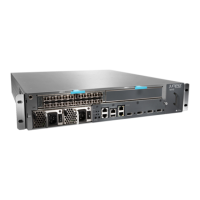Field-replaceable units (FRUs) are router components that can be replaced at the
customer site. Replacing FRUs requires minimal router downtime. There are three types
of FRUs:
•
Hot-removable and hot-insertable—You can remove and replace the component
without powering down the router or interrupting the routing functions.
•
Hot-pluggable—You can remove the component without powering down the router,
but routing functions are interrupted until the replacement is installed.
•
Requires router shutdown—You must power down the router before removing the
component.
Related
Documentation
T1600 Core Router Overview on page 34•
TX Matrix Router Overview
The Juniper Networks TX Matrix router is the centralized switch fabric of the routing
matrix, which is a terabit routing system interconnecting up to four T640 Core Routers
to deliver up to 2.56 terabits per second (Tbps) of subscriber switching capacity. The
routing matrix multichassis architecture provides scalable growth for aggregation and
core services for voice, video, and data networks. It provides a flexible and cost-effective
means to simplify large point-of-presence (POP) and central office environments. The
routing matrix delivers high-availability services from tunnel services, ATM, DS3,
OC3/STM1, OC12/STM4, Gigabit Ethernet, 10-Gigabit Ethernet, OC48/STM16,
OC192/STM64, and other high-speed interfaces. The routing matrix leverages the
intelligent virtual services capabilities of Junos OS, which enable you to create multiple
application-specific logical networks over a single physical topology. This gives you the
ability to virtually separate traffic types that require unique network attributes—such as
ATM or high-priority voice over IP (VoIP) and third-generation (3G) mobile traffic—from
bulk transit IP traffic.
The TX Matrix router architecture cleanly separates control operations from packet
forwarding operations. This design eliminates processing and traffic bottlenecks,
permitting the TX Matrix router to achieve terabit performance levels. Control operations
in the TX Matrix router are performed by the host subsystem, which runs Junos OS to
handle traffic engineering and configuration management. High-availability, interchassis
communications are provided by an Ethernet LAN that interconnects the host subsystems
in the TX Matrix router and the T640 routers. The TX Matrix router is a modular,
rack-mountable system. One TX Matrix router can be installed in one standard 19-in.
wide, 78-in. high, EIA telco rack. The TX Matrix router supports the Junos OS, which
provides router configuration and monitoring. (See Figure 17 on page 40 and Figure 18 on
page 41.)
39Copyright © 2012, Juniper Networks, Inc.
Chapter 2: T Series Core Routers

